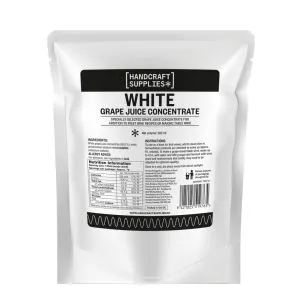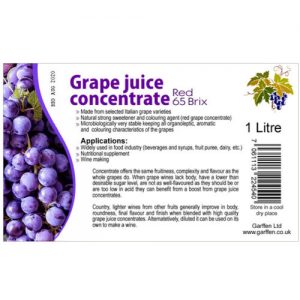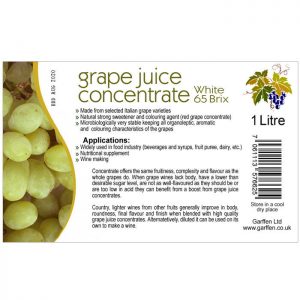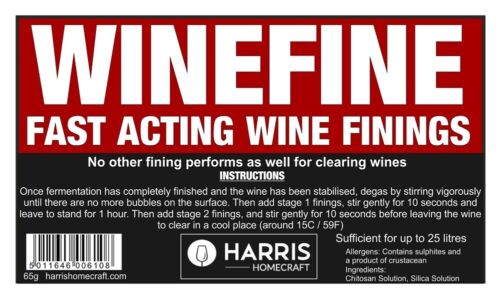Free postage on all orders over £90.
Coopers Beer Kits now in stock
View our latest Special Offers
5% Discount on orders over £125.00
-
0£0.00
- No products in the cart.
-
0£0.00
- No products in the cart.
Additives
A complete ingredient listing of the most popular additives for professional brewing and making your favorite homebrew beer.
Showing all 21 results
-
Specially selected red grape juice concentrate for use in wine recipes to improve quality and aid healthy fermentation.
-
Specially selected white grape juice concentrate for addition to fruit wine recipes or making table wine.
-
Acid Blend, powder. This is a mixture of tartaric, malic and citric acids in a 40-40-20 ratio. Its use is often prescribed in wine recipe books and used primarily for fruit wines (non grape). A single one or a combination of two of these acids will work about as well.
-
Ascorbic Acid is an anti-oxidant used as a partial substitute for sulfur dioxide, or used to prevent oxidation, which creates a dull and unpleasant flavor, and to prevent discoloring in the final product. Recommended for wines that discolor easily.
Ascorbic Acid, like Copper Sulfate, is often used to treat hydrogen sulfide (H2S) or ‘mercaptans’, which presents as a rotten egg scent in your wine. Try treating first with Copper Sulfate but if the problem persists, then treatment with Ascorbic Acid will be necessary. If you have advanced H2S ‘disulfide’, the scent could be described as burnt rubber or garlic-like and the wine will not improve with the treatment of Copper Sulfate alone. The use of 0.25gm Ascorbic Acid per gallon will often help by converting the disulfides back to mercaptans. The process may take up to three weeks, after which the wine should be treated with Copper Sulfate.
Use 0.25 grams of ascorbic acid per gallon.
-
Brupaks Irish Moss Copper Finings enables the brewer to achieve brighter worts by assisting the coagulation of unstable proteins in the copper and rapid settling of the coagulum as hot and cold breaks. It is important to produce consistently bright wort in order to reduce the level of protein and polyphenols. If high levels of these substances are present they will lead to draught beers that are difficult to fine or bottled beers with a greatly reduced shelf life. Whilst protein can to some extent be removed with auxiliary finings, it can present other problems which can be improved considerably by its removal in the copper.
Irish Moss is red brown flakes of seaweed (Chondrus crispus)The active compound is the polysaccharide Carageenan that carries a negative charge that interacts with proteins to form large flocs.
Method of Use
Irish Moss should be added to the copper 15 – 20 minutes before the end of the boil. This is to ensure that the active carrageenans are extracted.
Dosage
-
What Is Beer Brite?
Beer Brite finings are a very powerful form of dry isinglass finings. Isinglass is one of the main fining agents for clearing beer in the world and is used by virtually all breweries. The main problem with isinglass is that it needs to be kept constantly cool otherwise the product denatures and will not work. To overcome this, we have freeze-dried the isinglass at the point of making it up. Being a freeze-dried product, it can be stored at virtually any temperature without it losing any of its characteristics. Also, the free-drying extends the life of the finings considerably.
Why You Need It.
Although beers will eventually clear by themselves, sometimes this could be many months. Finings have a dual benefit when you add them to your beer, wine or cider. First, they attach to the haze and make it heavier, so it starts to settle quicker. As this is happening, the finings keeps absorbing the proteins that make up the haze, constantly getting bigger and heavier so it clears quickly.
Second, when the haze has fallen to a sediment, the finings starts to compact it, making less wastage. The sediment in its compact form is not so easily disturbed, so there is less chance of cloudy beer when pouring from a bottle.
Instructions
Add two level teaspoons of powder into half a cup of cold water. Whisk with a fork for 1 minute to thoroughly mix. Leave for 15 minutes, then whisk again before adding to 5 gallons (23L) of beer towards the end of fermentation. This has the benefit of producing the finings with 100% activity, so you are using a more powerful and stronger finings. This results in clear beer quickly with more compact sediment.
When liquid isinglass is manufactured, it starts to deteriorate. The longer it is kept, the less fining properties are left in the product. As the Beer Brite was freeze-dried when it was made up, and then you are adding the water later on, you are using the full 100% fining properties.
What Quantity Of Beer Will It Treat?
Beer Brite is available in a 3 dose pot to treat up to three 5 gallon brews (22.5 litres). Larger sizes are available for commercial breweries, such as 120g sachets to treat 100-gallon tanks of beer.
-
Protafloc tablets are a tabletted carrageenan product which is added to the wort in the kettle to enhance protein removal as the wort cools.The active ingredient in Protafloc tablets is a polysaccharide called carrageenan which is derived from seaweed. Carrageenan in solution isnegatively charged, owing to the sulphate groups along the polysaccharide backbone. It is these charged sites which interact with wort proteins.Protafloc tablets should be added to the kettle ten minutes prior to the end of the boil. The addition time reflects the length of time required to dissolve and disperse the carrageenan into the wort. Should Protafloc tablets be added early in the boil, then degradation of the polymer may occur and product efficiency is lost.Benefits:
- Natural product which removes substantial quantities of haze forming material without affecting head retention
- Produces brighter worts, reducing the amount of finings required later
- Increases rate of fermentation and attenuation
- Increases filter runs
- Prolongs shelf life in small pack beers
- Reduces process time
- Is a processing aid not an additive so doesn’t require label declaration
- Reduced tank losses
- 5-10% more efficient than competitive products
- Tabletted for easy use
-
What Is Cider Brite?
Cider Brite finings are a very powerful form of dry isinglass finings. Isinglass is one of the most effective fining agents available. The main problem with isinglass is that it needs to be kept constantly cool otherwise the product denatures and will not work. To overcome this, we have freeze-dried the isinglass at the point of making it up. Being a freeze-dried product, it can be stored at virtually any temperature without it losing any of its characteristics. Also, the free-drying extends the life of the finings considerably.
Why You Need It.
Although ciders will eventually clear by themselves, sometimes this could be many months. Finings have a dual benefit when you add them to your cider. First, they attach to the haze and make it heavier, so it starts to settle quicker. As this is happening, the finings keeps absorbing the proteins that make up the haze, constantly getting bigger and heavier so it clears quickly.
Second, when the haze has fallen to a sediment, the finings starts to compact it, making less wastage. The sediment in its compact form is not so easily disturbed, so there is less chance of cloudy cider when pouring from a bottle.
Instructions
Add two level teaspoons of powder into half a cup of cold water. Whisk with a fork for 1 minute to thoroughly mix. Leave for 15 minutes, then whisk again before adding to 5 gallons (23L) of cider at the end of fermentation. This has the benefit of producing the finings with 100% activity, so you are using a more powerful and stronger fining. This results in clear cider quickly with more compact sediment.
When liquid isinglass is manufactured, it starts to deteriorate. The longer it is kept, the less fining properties are left in the product. As the Cider Clear was freeze-dried when it was made up, and then you are adding the water later on, you are using the full 100% fining properties.
What Quantity Of Cider Will It Treat?
Cider Clear is available in a 3 dose pot to treat up to three 5 gallon brews (22.5 litres).
-
Winefine – Fast Acting Wine Finings – Treats up to 25 Litres – Harris
-
Used to Beer. A single part process Fining is the technique of adding substances to the beer to help clear them. Most stubborn hazes are colloidal (gluey substances) in nature and most fining agents are also colloidal. Finings act by neutralising the electrical charges on the haze forming particles so that they fall out of the solution. Sufficient for 23 Litres / 5 Gallons
Method of Use
Irish Moss should be added to the copper 15 – 20 minutes before the end of the boil. This is to ensure that the active carrageenans are extracted.
Dosage
-
An artificial sweetener used to sweeten dry wines once finished without the danger of re-starting fermentation.
-
Used to clear Wine. Fining is the technique of adding substances to the wine to help clear them. Most stubborn hazes are colloidal (gluey substances) in nature and most fining agents are also colloidal. Finings act by neutralising the electrical charges on the haze forming particles so that they fall out of the solution. Sufficient to treat up to 270 Litres.
-
Ideal for wine making. Imparts a natural, fruity citrus flavour.
A substitute for natural citrus aids a healthy fermentation.
Citric Acid Directions for use:
Use as directed in recipe or as a guide, use 10gm dissolved in a small amount of warm water per 4.5l, adding to must prior to fermentation, repeat if necessary after fermentation. One Rounded teaspoon is the equivalent to the juice of one lemon.
-
Our Ritchies Dried Elderberries are great for either making elderberry fruit wine or as an additive for wine, beers or ciders. Elderberries provide a tart flavour and come well-packaged in a sealed bag.
-
A substitute for fresh sloes when they are out of season, these dried sloes can be used to make sloe gin or sloe vodka
-
Improves colour, texture, tannin and flavour of your wine
-
Malic Acid, powder, food grade.
Both malic and citric acids are used to acidulate other fruits (commercial wines can legally only add acids that occur naturally in any particular fruit).
This acid is found almost universally in temperate fruits. It dominates in apples and together with tartaric acid accounts for most of the acid in grapes. The main disadvantage of malic acid is that it buffers to a fairly high pH.
The form of commercially available malic acid added to wines is not subject to M-L fermentations.
MALIC ACID FOR WINE MAKING USE ONLY
-
Tartaric Acid, powder, NF.
Helps to control the acidity of your wine. Since it is the primary acid component found in grapes, winemakers can adjust the acidity of their wine by adding tartaric acid to the wine.
Tartaric acid is the characteristic acid of grapes which is found in no other common fruit. Low acid grapes from warmer climates will benefit from its addition; the wine will clear more readily and will keep and taste better. It buffers to a nice low pH. Wines with acidity below 0.5% will benefit from its addition. It takes about 3.7 grams per gallon to increase acidity by 0.1%. Best practice is to add tartaric very early in the process.
-
Also known as Potassium Sorbate. Added to a wine to stop the fermentation and prevent a re-fermentation after bottling. Should always be used together with campden tablets, otherwise wine will get a smell of ‘Duranium’.
Showing all 21 results



















